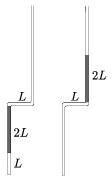Exercises and problems in Physics
May 2002
Please read The Conditions of the Problem Solving Competition.
 |
Experimental problem |
M. 234. The viscosity of fruit juices with fibre increases with cooling and decreases whith diluting. Take some measurements to decide which effect is ``stronger''. What happens to viscosity when the absolute temperature and the concentration decrease by the same percentage (e.g. 5, 10 and 15 percents)? Find a method, where it is easy to measure viscosity ratios. (6 points)
 |
Theoretical problems |
P. 3531. Some hikers hired a boat for 3 hours. The river flows at a speed of 2.5 km/h, and the speed of the boat is 7.5 km/h relative to the water. How far can they get from the port if they want to be back in 3 hours? (3 points)
P. 3532. We fix an inextensible thread to the ceiling and tie a body of mass m to the lower end of the thread as it is seen in the figure. To the bottom of the body we fix a spring and on it hangs a body of mass 2m. The system is in equilibrium. The dilation of the spring is 30 cm. Now burn the thread!

a) What is the acceleration of the bodies right after the thread is burnt?
b) How long will it take the spring to reach its unstretched state first and what is the velocity of the bodies at that moment? (5 points)
P. 3533. It is hailing on a flat area of 10 000 m2 uniformly in time for 41 seconds in a uniformly random areal distribution. The hailstones, which can be considered as uniform spheres, fall on a soil which they only slightly indent. Only those move further from their place of impact that fall on their comrades. Among the 20 000 hailstones that fell in the last second there were 200 which fell on those that landed in the previous 40 seconds. a) What is the percentage of the ice covered area? b) What is the area of the great circle of an ice sphere? (5 points)
P. 3534. What thickness layer of a snow-blanket of 20 cm depth, 0 oC temperature and 0.25 kg/dm3 density melts after 5 hours of sunshine when the radiation includes an angle of 25o with the snow layer on average? At the top of the atmosphere at every surface element of 1 m2 which is perpendicular to the radiation of the Sun the incoming radiation power is 1350 W. 50% of this is absorbed in the atmosphere, and the snow reflects 90% of the energy incoming. (4 points)
P. 3535. The tube of cross section A seen in the figure is closed at one end, bent twice in right angles and resides in a vertical plane. The L=38 cm long air column of temperature T0 in the vertical part of the tube is closed off by a 2L long mercury column. The length of the horizontal part of the tube is L. The p0 air pressure outside equals with the hydrostatic pressure of the 2L high mercury column. Let L.A be termed V0.

a) Give in p0V0 units the work done by the expanding air while the mercury flows to the upper vertical tube.
b) What percentage of the heat transmitted to the air increases the internal energy?
c) Plot the air temperature against its volume. (5 points)
P. 3536. A slightly divergent electron beam of 5 keV energy arrives at a homogeneous magnetic field. The velocity of the particles include only small angles with B. What magnetic induction is needed to ensure that the electrons meet again at a 10 cm distance? (5 points)
P. 3537. In a Compton scattering (the elastic collision of an electron and a photon) event the momentum of an initially resting electron became greater than that of the incident photon of frequency f was. At least at what angle did the photon scatter? (5 points)
P. 3538. The kinetic energy of an electron is the nth of that of a photon and its momentum is n times as much as the momentum of the photon. At what n values are photons like this visible? (4 points)
P. 3539. We are holding with our arm outstretched a collector lens of focal distance of f=12 cm, and observing a 24 meter high tower at a 60 meter distance. Using estimated data determine the size of the image on the retina of our eye. At what enlargement or reduction do we see the tower through the lens compared to the naked eye? How much is the dioptre of our eye in the two cases? (5 points)
P. 3540. The SOHO satellite observing the Sun's eruptions is always on the line connecting the Sun and the Earth. How far is SOHO from the Earth? (Take Earth's orbit as a circle.) (6 points)
Send your solutions to the following address:
- KöMaL Szerkesztőség (KöMaL feladatok),
Budapest 112, Pf. 32. 1518, Hungary
